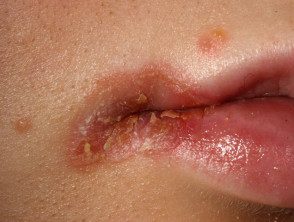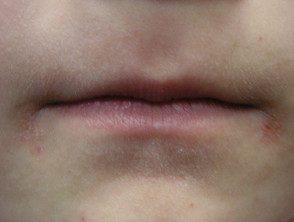What is angular cheilitis?
Angular cheilitis is common. inflammatory condition affecting the corners of the mouth or oral commissures. Depending on the underlying causes, it can last a few days or persist indefinitely. Also called angular stomatitis, cheilosis and perleche (perlèche).
Angular cheilitis

Candida

Impetigo

Candida + staphylococcus
See more images of angular cheilitis.
What causes angular cheilitis?
Angular cheilitis is due to one or more of the following factors:
- A saliva drip causing eczematous cheilitis, a form of contact irritating dermatitis
- A protrusion of the upper lip that produces deep grooves (puppet lines)
- Dry and chapped lips
- Proliferation of bacteria (impetigo), yeast (thrush) or virus (cold sore).
Who is prone to angular cheilitis?
Angular cheilitis is common and affects children and adults, especially when they are in poor health. Predisposing factors include:
-
Oral candidiasis: childhood, old age, diabetes, systemic use of corticosteroids or antibiotics
- Dentures, especially if they don't fit well, and there is an associated gum recession
-
Poor nutrition: celiac disease, iron deficiency, riboflavin deficiency
- Systemic disease, particularly inflammatory bowel disease (ulcerative colitis and Crohn's disease)
- Sensitive skin, especially atopic dermatitis
- Genetic predisposition, for example in Down syndrome
- Oral retinoid medication: isotretinoin for acne, acitretin for psoriasis.
It is made worse by licking lips.
What are the clinical features of angular cheilitis?
Angular cheilitis can cause the following symptoms and signs at the corners of the mouth:
- Painful cracks /fissures
- Blisters, erosionsoozing crust
- Redness
- Bleeding
Can progress to more extended impetigo or candidiasis in the adjacent skin and elsewhere.
What investigations can be done in angular cheilitis?
the culture Swabs taken from the corners of the mouth may reveal:
- Candida albicans
- Staphylococcus aureus
- Herpes Simplex
Skin biopsy It is not usually necessary.
What is the treatment of angular cheilitis?
In many cases, no treatment is needed and angular cheilitis resolves on its own. Depending on the specific cause, the following treatments may be helpful:
- Lip balm or thick emollient ointment, applied frequently
- Current antiseptics
- Topical or oral antibiotic antistaphylococcal
-
Topical antifungal cream
-
Oral antifungal medication
-
Topical steroid ointment
- Nutritional supplements
- Filler injections or implants to build the oral commissures.
-
Botulinum toxin to smooth the lines.

